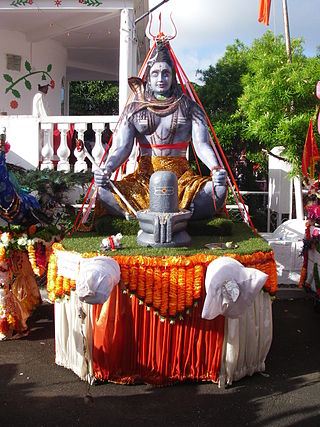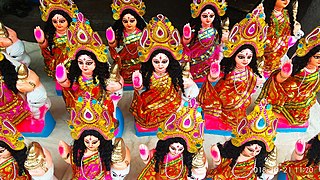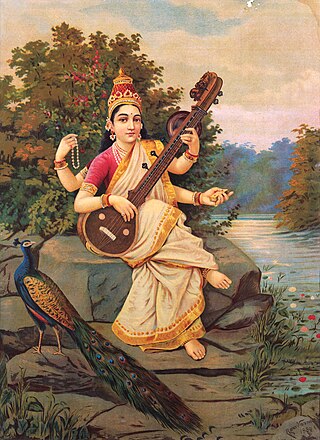
Maha Shivaratri is a Hindu festival celebrated annually in honour of the deity Shiva, between February and March. According to the Hindu calendar, the festival is observed on the fourteenth day of the first half of the lunar month of Phalguna. The festival commemorates the wedding of Shiva and Parvati, and the occasion that Shiva performs his divine dance, called the Tandava.

Bargarh is one of the major towns of Western Odisha and a municipality in Bargarh district in the state of Odisha in India. It is the administrative headquarters of Bargarh District and an important town of Odisha because it is known as the "rice bowl of Odisha" due to its intense rice production, it is an agro-industrial hub and is also known as "city of handloom" because sambalpuri sari originated from here."Dhanu jatra" of Bargarh is world famous and is known as the "world's largest open air theatre". Bargarh was awarded with the "fastest moving city" award under the 50k-100k category in Swachh Sarbekhyan 2022 in the east zone.

The culture of Nepal encompasses the various cultures belonging to the 125 distinct ethnic groups present in Nepal. The culture of Nepal is expressed through music and dance; art and craft; folklore; languages and literature; philosophy and religion; festivals and celebration; foods and drinks.
Banepa is a municipality and historical town in a valley situated at about 1,500 m (4,900 ft) above sea level in central Nepal which is at about 25 kilometres (16 mi) east from Kathmandu. At the time of the 2011 Nepal census, it has a population of 67,690. The main attraction of Banepa is the temple of Chandeshwori, located approximately 1 km (0.62 mi) northeast of the town along the Rudramati River. The Dhaneshwor Temple is 1 kilometre south of the town. Banepa is also known for its eight different temples of Ganesh, Narayanthan, Bhimshenthan, and eight different ponds.

Sharad Purnima is a religious festival celebrated on the full moon day of the Hindu lunar month of Ashvin, marking the end of the monsoon season. The full moon night is celebrated in different ways in various cultural regions across Indian subcontinent.

Kathmandu District is a district located in Kathmandu Valley, Bagmati Province of Nepal. It is one of the 77 districts of Nepal, covers an area of 413.69 km2 (159.73 sq mi), and is the most densely populated district of Nepal with 1,081,845 inhabitants in 2001, 1,744,240 in 2011 and 2,017,532 in 2021. The administrative headquarters of Kathmandu district is located in Kathmandu. The city has 21 post offices which handle mail from across the country and beyond, with Kathmandu DPO having 44,600 as its postal code for international mail delivery services like UPS or DHL Couriers etc.
Kolkata has many festivals throughout the year. The largest and most magnificently celebrated festival of the city is Durga Puja, and it features colourful pandals, decorative idols of the Hindu goddess Durga and her family, lighting decorations and fireworks. Other major festivals are Diwali, Kali Puja, Holi, Saraswati Puja, Poush Parbon, Poila Boishakh, Christmas, Eid al-Fitr, and Eid al-Adha.

Vasant Panchami, also rendered Vasanta Panchami and Saraswati Puja in honour of the Hindu goddess Saraswati, is a festival that marks the preparation for the arrival of spring. The festival is celebrated in Indian religions in different ways depending on the region. Vasant Panchami also marks the start of preparation for Holika and Holi, which take place forty days later. The Vasant Utsava (festival) on Panchami is celebrated forty days before spring, because any season's transition period is 40 days, and after that, the season comes into full bloom.

The Pashupatinath Temple is a Hindu temple dedicated to Pashupati, a form of Shiva. It is located in Kathmandu, Nepal, on the bank of the Bagmati River. The temple was classified as a World Heritage Site in 1979. This "extensive Hindu temple precinct" is a "sprawling collection of temples, ashrams, images and inscriptions raised over the centuries along the banks of the sacred Bagmati river", and is one of seven monument groups in UNESCO's designation of Kathmandu Valley. The temple, considered one of the holiest pilgrimage sites for Hindus, is built on an area of 246 hectares and includes 518 mini-temples and a main pagoda house.
This article lists the traditional festivals and other cultural events in the Odisha region of India. Odisha celebrates 13 festivals in 12 months as the saying goes Bāra Māsare Tera Parba.

Bode is an ancient Newar city in the east corner of the Kathmandu Valley, Nepal, about eight miles from the capital city, Kathmandu.The city is famous for Biska Jatra and tongue piercing and Nilbharahi Naach. At the time of the 2011 Nepal census it had a population of 6,364 with 1,389 houses.

Naagdesh (Nagadesh) is an ancient Newar city in Madhyapur Thimi Municipality in Bhaktapur District in the Bagmati Zone of central Nepal. In 2011 it had a population of approximately 6,900 with more than 1500 houses in it, according to the 2011 Nepal census. At the time of the 1991 Nepal census it had a population of 4,237 with 693 houses in it. Most people are engaged in farming.

Khokana is a former Village Development Committee (VDC) which has been merged with the neighbouring VDC's of Bungamati, Chhampi, Dukuchhap, Sainbu and other 38 VDC's to form the Metropolitan City of Lalitpur in Lalitpur District in the Bagmati Zone of central Nepal. At the time of the 1991 Nepal census, Khokana had a population of 4258 living in 699 individual households. According to 2011 Nepal census, Khokana had a population of 4927 living in 1056 individual households.
Sunaguthi is a small town located about 4 km (2.5 mi) south of the main Lalitpur city in Lalitpur District. According to 2011 Nepal census, Sunaguthi has a population of 10,092 living in 2397 individual households. Most of the people living in Sunaguthi are Newar. The offshoot road near the Satdobato segment of the Ring Road leads to Sunaguthi. This road ultimately leads to Lele and is referred to as Laxmi Prasad Devkota Marga .Thecho is situated on the southern part of Sunaguthi, Bungamati and Bhaisipati on west, Dhapakhel on east and Khumaltar and Nakhipot on North. The famous jatras of sunaguthi are yomari punhi, gathamuga,bhimsen jatra, chakha jatra, pekha jatra, etc.
Here is a list of glossary of culture of India in alphabetical order:

Mohani, also known as Moni or Mohni is annual religious festival celebrated by the Newar people of Nepal. It is analogous to Dashain, a Hindu festival celebrated in South Asia, although Mohani celebrated by both Hindus and Buddhists. The festival is based on the lunar calendar and starts on the first day of the bright fortnight of Kaula, around late September and lasts for fifteen days till the full moon.

Shreekhandapur is a city situated in the Dhulikhel municipality in Kavrepalanchowk district in Nepal.This historical town is about 28 km east from Kathmandu. The city is located roughly at 1400m above sea level. The main attraction of Shreekhandapur is the temple of Swet Bhairav, located approximately 1 km northeast of the town. The name Shreekhandapur was originally given due to the presence of the tree Shreekhand. Its name during the Licchavi period was खम्पू which is still used predominantly by the Newar community living in this town.

The Siddhikali Temple is a Hindu temple located in Thimi, Nepal. The two-storey roofed temple is dedicated to Kali, Shiva and Ganesh. It is also believed that this Shaktipeeth was formed the fallen right eye of Sati's corpse. This place is located in Inayekwo, in the north west of Thimi. The temple is also known as Inayekwo Dyo in the Nepalese Bhasa language. The Siddhikali Temple is also known as Chamunda, one of the goddesses of Astamatrika. The majestically impressive Siddhikali temple has numbers of Pataa streaming down the front. There is a Satah (rest-house) opposite to the temple and multiple Falcha (Inns) and several smaller shrines to the rear and nearby, and several stone taps around the place.

Dance is a performing art form consisting of purposefully selected sequences of human movement. Dance (Nepali: नृत्य/ नाच) in Nepal comprises numerous styles of dances, including folk, ethnic, classical to modern dances. Lakhey is the dance of a demon in the carnival of God. Durbar Square, a historic plaza in Kathmandu, Nepal, facing ancient palaces and adorned by Hindu temples, is always full of eager crowds on the last day of Indra Jatra, the festival celebrating Indra, the Hindu king of heaven. In this divine stage, Lakhe the demon dances among gods and deities relentlessly and carelessly.

















